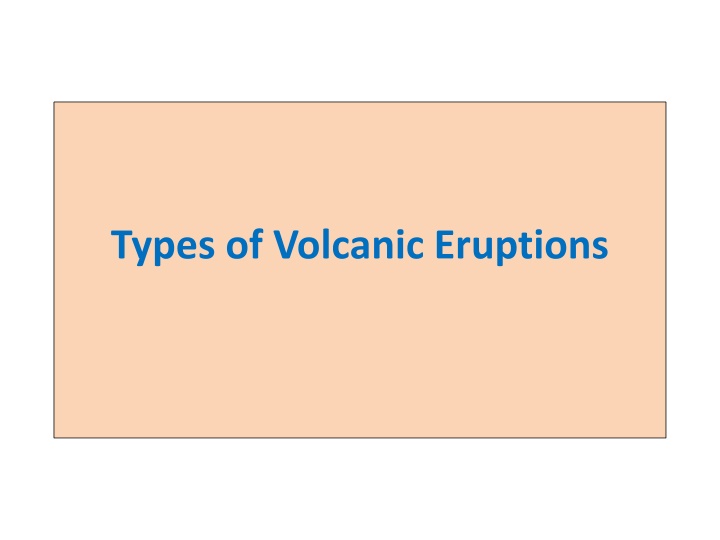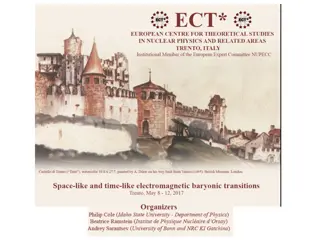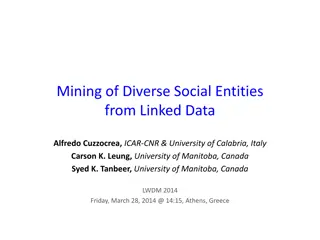
Pattern of Behavior in Various Types of Volcanic Eruptions
Discover the distinctive behaviors displayed by volcanoes during different types of eruptions, ranging from mild steam discharges to violent explosions. Learn about Strombolian, Vulcanian, Vesuvian, Pelean, Hawaiian eruptions, and the potential devastation they can cause. Witness the immense power of nature through examples like the Irazu and Parícutin volcanoes, Mount Vesuvius, and the Mayon Volcano. Uncover the risks posed by Peléan or Nue Ardente eruptions and their tragic historical consequences, such as the destruction of St. Pierre in Martinique during the Mont Pelée eruption of 1902.
Download Presentation

Please find below an Image/Link to download the presentation.
The content on the website is provided AS IS for your information and personal use only. It may not be sold, licensed, or shared on other websites without obtaining consent from the author. If you encounter any issues during the download, it is possible that the publisher has removed the file from their server.
You are allowed to download the files provided on this website for personal or commercial use, subject to the condition that they are used lawfully. All files are the property of their respective owners.
The content on the website is provided AS IS for your information and personal use only. It may not be sold, licensed, or shared on other websites without obtaining consent from the author.
E N D
Presentation Transcript
During an episode of activity, a volcano commonly displays a distinctive pattern of behavior. Some mild eruptions merely discharge steam and other gases, whereas other eruptions extrude quantities of lava. The most spectacular eruptions consist of violent explosions that blast great clouds of gas-laden debris into the atmosphere.
The Thetype of volcanic eruption type of volcanic eruptionis often labeled with the name of a well is often labeled with the name of a well- - known volcano where characteristic behavior is similar known volcano where characteristic behavior is similar hence the use of such terms as Strombolian, Vulcanian, Vesuvian, Pelean, of such terms as Strombolian, Vulcanian, Vesuvian, Pelean, Hawaiian, and others. Some volcanoes may exhibit only one Hawaiian, and others. Some volcanoes may exhibit only one characteristic type of eruption during an interval of activity characteristic type of eruption during an interval of activity others may display an entire sequence of types. display an entire sequence of types. hence the use others may
Strombolian Type eruption observed during the 1965 activity of Irazu Volcano in Costa Rica, huge clots of molten lava burst from the summit crater to form luminous arcs through the sky. Collecting on the flanks of the cone, lava clots combined to stream down the slopes in fiery rivulets. In contrast, the eruptive activity of Par cutin Volcano in 1947 demonstrated a Vulcanian -type eruption, in which a dense cloud of ash-laden gas explodes from the crater and rises high above the peak. Steaming ash forms a whitish cloud near the upper level of the cone.
Vesuvian eruption eruption, as typified by the eruption of Mount Vesuvius in , as typified by the eruption of Mount Vesuvius in Italy in A.D. 79, great quantities of ash Italy in A.D. 79, great quantities of ash- -laden gas are violently discharged to form cauliflower violently discharged to form cauliflower- -shaped cloud high above the volcano. above the volcano. laden gas are shaped cloud high
Pelan or Nue Ardente (glowing cloud) eruption, such as occurred on the Mayon Volcano in the Philippines in 1968, a large quantity of gas, dust, ash, and incandescent lava fragments are blown out of a central crater, fall back, and form tongue-like, glowing avalanches that move down slope at velocities as great as 100 miles per hour. Such eruptive activity can cause great destruction and loss of life if it occurs in populated areas, as demonstrated by the devastation of St. Pierre during the 1902 eruption of Mont Pel e on Martinique, Lesser Antilles.
Hawaiian eruptions may occur along fissures or fractures that serve as linear vents, such as during the eruption of Mauna Loa Volcano in Hawaii in 1950; or they may occur at a central vent such as during the 1959 eruption in Kilauea Iki Crater of Kilauea Volcano, Hawaii. In fissure-type eruptions, molten, incandescent lava spurts from a fissure on the volcano's rift zone and feeds lava streams that flow down slope. In central-vent eruptions, a fountain of fiery lava spurts to a height of several hundred feet or more. Such lava may collect in old pit craters to form lava lakes, or form cones, or feed radiating flows.
Phreatic or steam-blast eruptions are driven by explosive expanding steam resulting from cold ground or surface water coming into contact with hot rock or magma. The distinguishing feature of phreatic explosions is that they only blast out fragments of preexisting solid rock from the volcanic conduit; no new magma is erupted. Phreatic activity is generally weak, but can be quite violent in some cases, such as the 1965 eruption of Taal Volcano, Philippines, and the 1975-76 activity at La Soufri re, Guadeloupe (Lesser Antilles).
Plinian The most powerful eruptions are called Plinian and involve the explosive ejection of relatively viscous lava. Large plinian eruptions such as during 18 May 1980 at Mount St. Helens or, more recently, during 15 June 1991 at Pinatubo in the Philippines can send ash and volcanic gas tens of miles into the air. The resulting ash fallout can affect large areas hundreds of miles downwind. Fast-moving deadly pyroclastic flows ( nu es ardentes ) are also commonly associated with plinian eruptions.






















